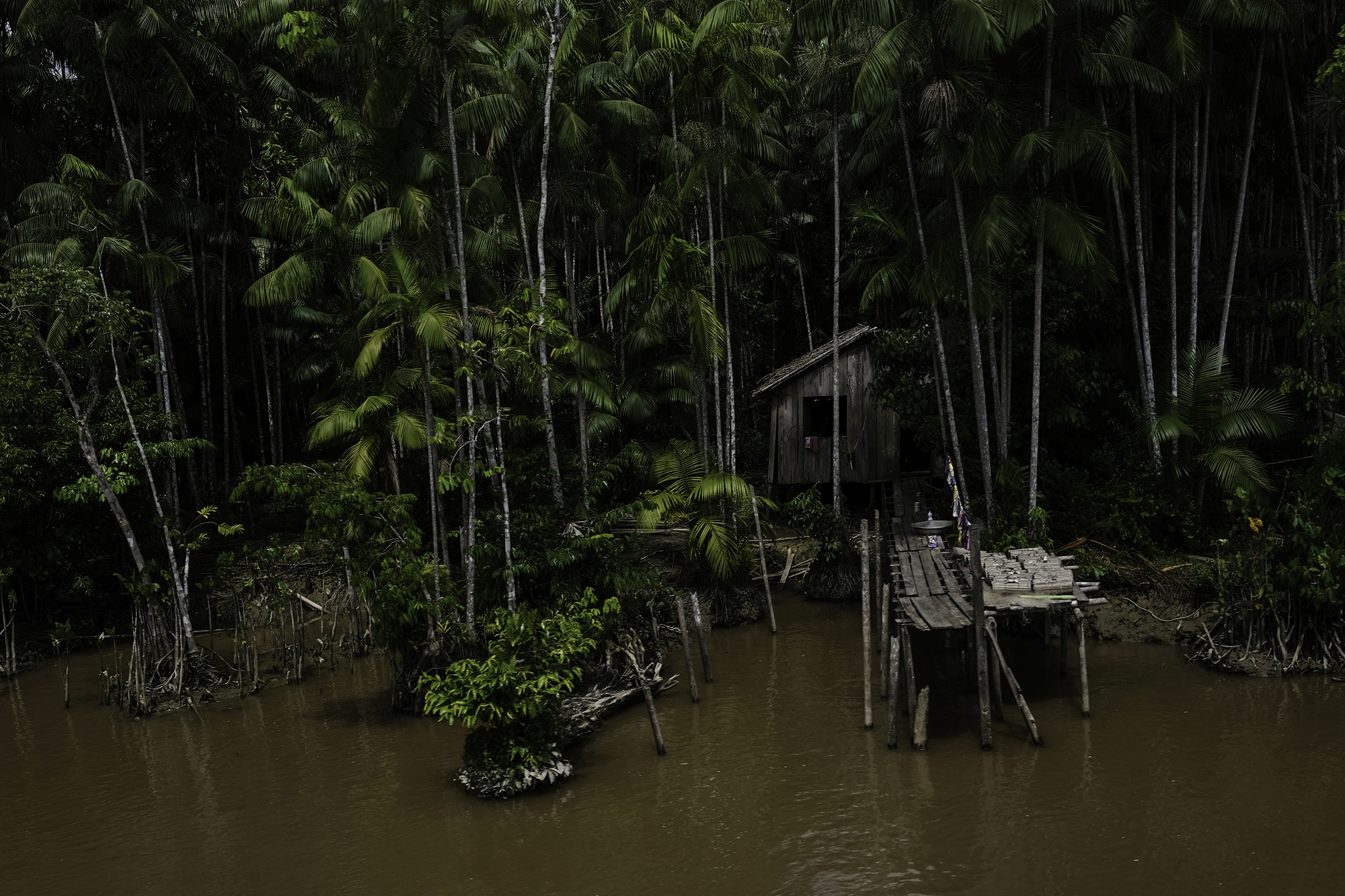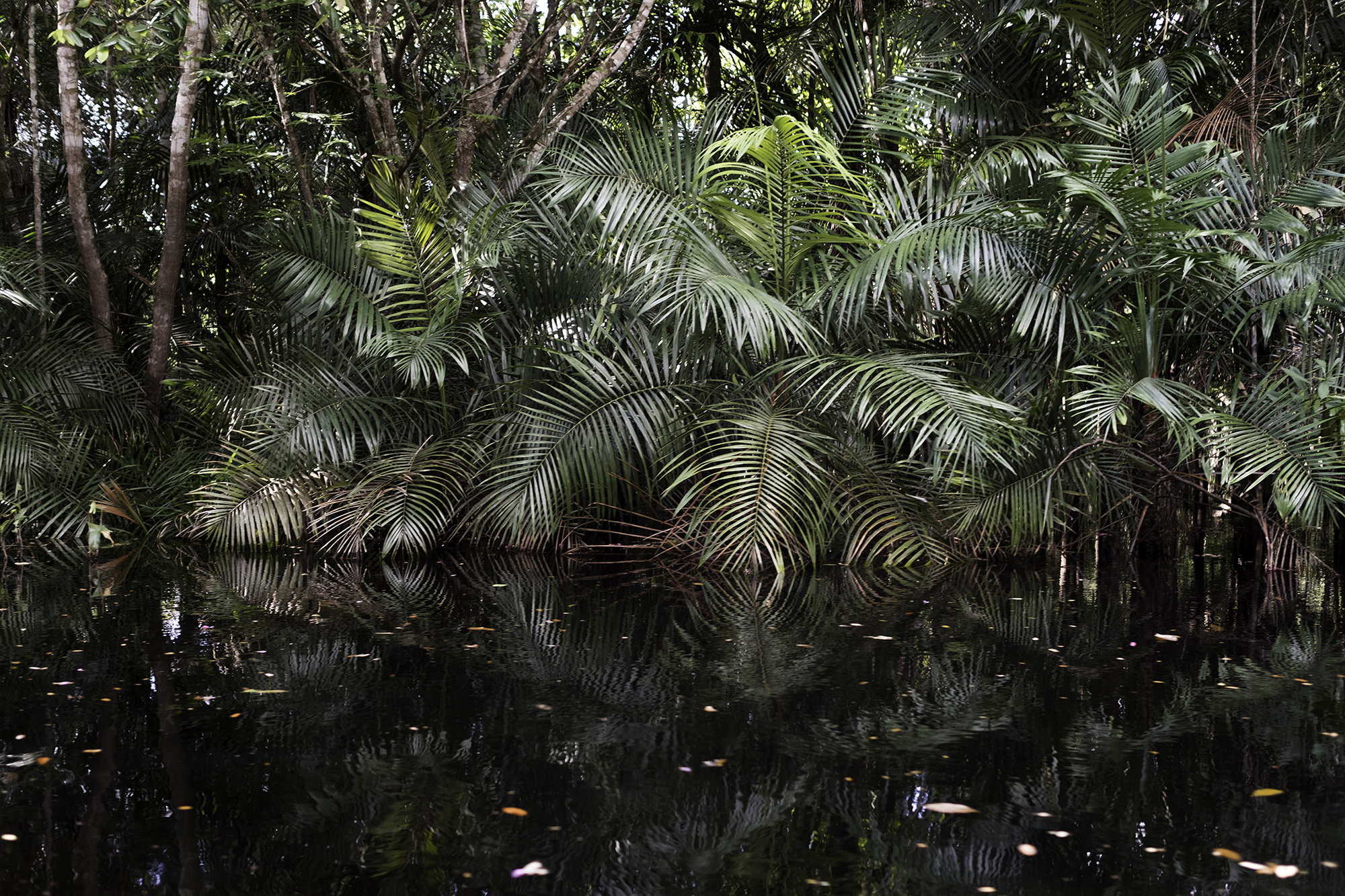Il tempo in Amazzonia non era come nel resto del pianeta, non si misurava in ore, bensì in albe, maree, stagioni, piogge.
La città delle bestie, Isabel Allende
Almeno un mese della propria vita, meglio se in momenti di passaggio e prima di prendere importanti decisioni, lo si dovrebbe impiegare per navigare il Rio Amazonas. FLUXO è la sintesi di un’ esperienza durata 4000 km partita da Belém, la capitale dello stato di Parà che si trova in’ un importante posizione strategica sulla foce del Rio delle Amazzoni nel nord del Brasile, ed arrivata alla triplice frontiera tra Perù, Colombia e Brasile. I mezzi di trasporto utili per muoversi in questo contesto sono dei barconi destinati al trasporto di persone e merce varia. Non appena entrati sul barcone se non si affitta una delle poche cabine disponibili va agganciata sul ponte l’amaca che diventerà il proprio spazio personale, vicino si alterneranno persone che salgono e scendono ed attraversano il fiume, talvolta anche degli indigeni. Il viaggio è scandito dallo scorrere delle acque del fiume e dei suoi bracci. Un armonioso FLUXO che gli indigeni Dessana chiamano “nomè isimiri bogà” associandolo alla dolce corrente, un principio “generatore” femminile. Il Rio Amazonas con l’attraversare i territori cambia di colore, dimensioni, intensità. Talvolta lo si percorre diviso in stretti canali altre si può ammirare in tutta la sua imponenza. Non appena si raggiunge Santarem le acque caffelatte del Rio Amazonas rifiutano di fondersi con quelle più scure del Rio Tapajos rendendo visibile il primo dei confini intangibili da superare in questa avventura. Facendo tappa a Santarem si può accedere attraverso questo suo affluente alla Floresta Nacional do Tapajós dove si trovano tratti meravigliosi di “flona” da percorrere accompagnati dalle guide indigene poichè la foresta è abitata anche da animali pericolosi come giaguari, serpenti corallo e tarantole. Le foreste allagate invece oltre ai piraña ospitano anche i caimani. Riprendendo il Rio Amazonas si incontrano diversi porti e città nati sulle sue sponde e in ciascuna di esse è possibile scendere e salire per brevi soste della durata del carico/scarico merci e persone. Manaus è la capitale della provincia di Amazonas e la città sembra proprio sottratta a quella che sarebbe la sua vera natura selvaggia, sugli alberi infatti crescono liane ed ulteriori piante che librano nell’aria le loro radici pronte a riprendersi ciò che sarebbe il loro spazio. Intorno alla città le comunità cabocle e indigene si alternano nella foresta. Talvolta alcuni si avvicinano ai barconi con le loro canoe per vendere pasti ai viaggiatori o per ricevere qualcosa in dono come scarpe ed abiti. Se si ha l’ opportunità di vivere insieme a loro si possono conoscere storie, danze, sciamani, tradizioni oppure metodi di pesca o caccia di armadilli e caimani, lavorazioni della manioca e delle foglie di palme che una volta intrecciate ricoprono abitazioni e la mal-oca. Le giornate lungo il Rio sono produttive ma lente, umide e calde. Ogni cosa va conquistata a partire dalle più essenziali come il cibo e l’acqua. Con il Rio si ha a che fare per qualsiasi necessità come per pulirsi, per cucinare, per lavare i propri effetti personali, per pescare, per cacciare, per raggiungere altri villaggi. Il Rio per chi abita le sue sponde è la primaria fonte di sostentamento, una continua energia che sia autorigenera, un dolce miele che scorre portando con se la vita. Vi abitano persino dei delfini rosa che chiamano “boto”. Il Rio Amazonas da Manaus prosegue in diverse direzioni una delle quali arriva fino alla “triplice frontiera” attraverso il Rio Solimoes raggiungendo Tabatinga e Bejamin Constant per poi passare senza percepire la frontiera a Santa Rosa ed Islandia in Perù o Leticia in Colombia. Le lingue, le monete, i traffici commerciali si fondono senza distinzione ed è il fiume creando anse e territori che si compenetrano a favorire questa osmosi. E’ sbalorditivo vedere insieme e contemporaneamente tante fisionomie, tradizioni, religioni fino alle sette israelitiche che fanno sacrifici di animali, vestono tuniche, guariscono con la parola e aspettano la venuta del messia a Machu Pichu vivendo secondo una ferrea “ley real”.
Ho amato molto questi 4000 km dormiti in amaca, cullata dalla corrente del Rio Amazonas, dai rumori della foresta, dai picchi che scavano incessantemente tutta la notte, dalla luna i cui spicchi ho visto per la prima volta “al contrario”, ho fatto sogni incredibili e ripercorso in essi momenti della vita che pensavo risolti e che ancora avevano qualcosa da dirmi. Mi son posta molte domande ed al termine del viaggio ero serenamente senza risposte, pronta a ripartire e reimmergermi in questo FLUXO.
EN
One should dedicate at least one month of their own life to navigate the Amazonas River, ideally in moments of transition and before making important decisions.
FLUXO is the synthesis of a 4000 km experience from Belém, the capital of the state of Parà, which is located in an important strategic position at the mouth of the Amazon River in the north of Brazil, and reaches the triple border between Peru, Colombia and Brazil. The means of transport used for moving in this context are boats for transporting people and various goods. As soon as you enter the boat,and unless you rent one of the few cabins available, a hammock which becomes your own personal space gets attached to your deck, which is close to people going up and down and crossing the river, sometimes even the natives. The journey is marked by the flowing waters of the river and its arms. A harmonious FLUXO that the indigenous Dessana call “nomè isimiri bogà” associating it to the sweet current, a female “generator” principle. The Rio Amazonas changes in color, size and intensity as it crosses different territories. Sometimes you have to go through it as it is divided into narrow channels, whereas at times it can be admired in all its grandeur. As soon as you reach Santarem, the caffeine waters of the Amazonas River refuse to merge with the darker ones of the Rio Tapajos thus making visible the first intangible boundary that has to be overcome in this adventure. Making a stop in Santarem you can access through its tributary the Floresta Nacional do Tapajós where there are wonderful stretches of “flona” where you need to be accompanied by indigenous guides because the forest is also inhabited by dangerous animals such as jaguars, coral snakes and tarantulas. The flooded forests, in addition to the piraña, also host the caimans. Resuming the Rio Amazonas, there are several ports and cities born on its banks and in each of them it is possible to get on and off, for short stops while the loading / unloading of goods and people takes place. Manaus is the capital of the province of Amazonas and the city seems to be stolen from what would be its true wild nature. Lianas and other plants grow on the trees soaring their roots in the air as if trying to recover what their own space would normally be. Around the city the cabocles and indigenous communities alternate in the forest. Quite often, some of them approach the boats with their canoes in order to sell meals to travelers or to receive gifts such as shoes and clothes. If you have the opportunity to live with them for a while, you can learn about stories, dances, shamans, traditions or methods of fishing and hunting for armadillos and caimans, processing of manioc and palm leaves that once intertwined, cover homes and malocas. The days along the Rio are productive but slow, humid and warm. Everything must be conquered starting from the most essential ones, like food and water. The Rio river covers every single need. Cleaning, cooking, washing one’s belongings, fishing, hunting, even reaching other villages. For those who live on its shores, the Rio is the primary source of sustenance, a continuous energy that is self-generating, a sweet honey that flows and simultaneously brings life with it. It even houses pink dolphins that are called “boto”. The Rio Amazonas from Manaus continues in different directions, one of which leads to the “triple border” through the Rio Solimoes reaching Tabatinga and Bejamin Constant and then passes without perceiving the border at Santa Rosa and Islandia in Peru or Leticia in Colombia. Languages, coins, commercial traffic merge without distinction and it is the river creating loops and territories that interpenetrate to favor this osmosis. It is astonishing to see at the same time gathered together all those faces, traditions, religions, even Israeli sects that sacrifice animals, wear tunics, use speech to heal and are expecting the coming of the Messiah to Machu Pichu, while living according to an iron “ley real”.
I loved these 4000 km sleeping in a hammock, cradled by the current of the Amazonas River, by the sounds of the forest, by the peaks that incessantly dig all night, from the moon whose segments I saw for the first time “upside down”, I had incredible dreams and retraced in them moments of life that I thought were resolved but that still had something to say to me. I asked myself many questions and at the end of the trip I was serenely without answers, ready to leave and re-immerse myself in this FLUXO.


























